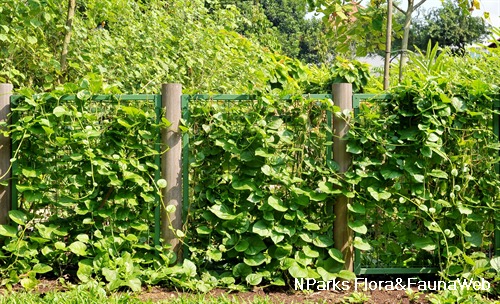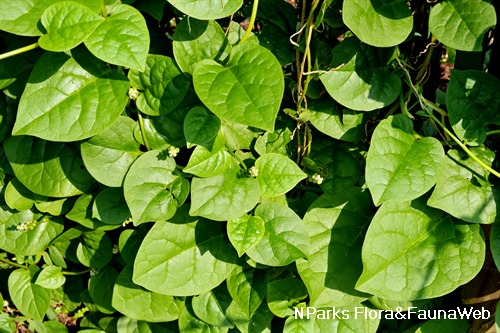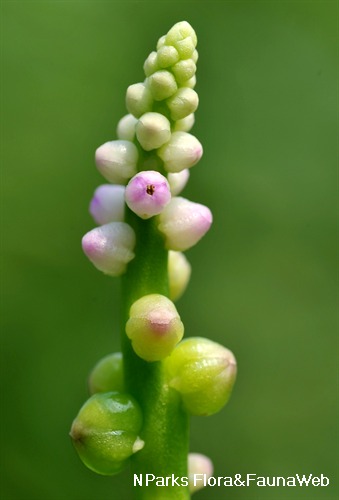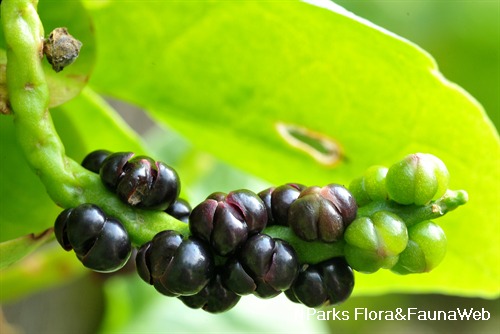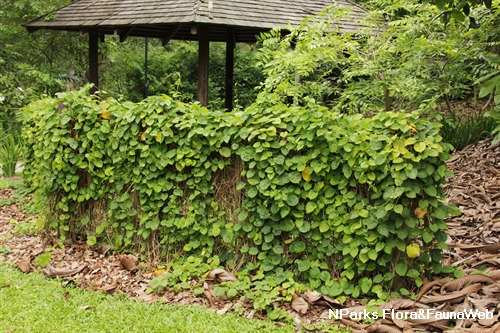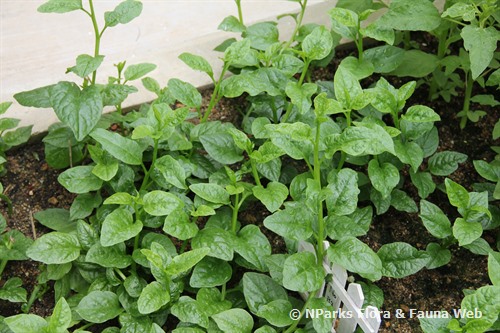
Back
Basella alba
| Family Name: | Basellaceae |
| Common Name: | Indian Spinach, Ceylon Spinach, 落葵, 帝皇苗, 木耳菜 |
Name
Classifications and Characteristics
| Plant Division | Angiosperms (Flowering Seed Plants) (Dicotyledon) |
|---|---|
| Plant Growth Form | Climber, Creeper |
| Lifespan (in Singapore) | Perennial |
| Mode of Nutrition | Autotrophic |
| Maximum Height | 2 m to 6 m |
Biogeography
| Native Distribution | Bangladesh, India, Sri Lanka, Cambodia, Laos, Myanmar, Thailand, Vietnam, Malesia, New Guinea |
|---|---|
| Native Habitat | Terrestrial |
| Preferred Climate Zone | Tropical, Sub-Tropical / Monsoonal |
| Local Conservation Status | Non-native (Horticultural / Cultivated Only) |
Description and Ethnobotany
| Growth Form | Short-lived perennial creeping or climbing vine with stems up to 2-6 m long. |
|---|---|
| Foliage | Leaves are ovate to cordate (egg-shaped to heart-shaped) with a slightly wavy leaf margin (5-15 cm long, 4-10 cm wide). They have a thick cuticle (waxy, protective outer layer). |
| Stems | Green or purplish stems are hairless, thin and twining. The plant forms runners which take root and form new plants. |
| Flowers | Inconspicuous, egg-shaped flowers (3-4 mm long) are arranged in a spike inflorescence. The bisexual flowers have 3 styles (female reproductive part) and 5 stamens (male, pollen-bearing part). |
| Fruit | Purplish black, round to slightly flattened fruits are fleshy and considered a pseudo-berry (4-7 mm long, 5-10 mm wide). |
| Ethnobotanical Uses | Edible Plant Parts : Edible Leaves, Edible Stems Food (Fruit or Vegetable): The leaves and stem tips are eaten cooked or raw as a vegetable in many countries. Medicinal: In Chinese folk medicine, leaves and stems are used as laxative, while flowers are used as poison antidotes. In Javanese folk medicine, the fruit is used to treat conjunctivitis, while roots are used to treat diarrhoea and swellings. |
Landscaping Features
| Landscape Uses | Trellis / Arbour / Pergola, Hedge / Screening, Container Planting |
|---|---|
| Thematic Landscaping | Economic Garden |
Fauna, Pollination and Dispersal
| Fauna Pollination Dispersal Associated Fauna | Bird-Attracting |
|---|
Plant Care and Propagation
| Light Preference | Full Sun |
|---|---|
| Water Preference | Moderate Water |
| Plant Growth Rate | Fast |
| Rootzone Tolerance | Moist Soils, Well-Drained Soils, Easy to Grow |
| Diseases | This species is seldom attacked by diseases. |
| Pest(s) | Nematodes |
| Propagation Method | Seed, Stem Cutting |
| Seed / Spore Germination Duration | 7 days |
Foliar
| Foliage Retention | Evergreen |
|---|---|
| Mature Foliage Colour(s) | Green |
| Mature Foliage Texture(s) | Smooth |
| Prominent Young Flush Colour(s) | Green |
| Young Flush Texture(s) | Smooth |
| Foliar Type | Simple / Unifoliate |
| Foliar Arrangement Along Stem | Alternate |
| Foliar Attachment to Stem | Petiolate |
| Foliar Shape(s) | Non-Palm Foliage (Ovate, Cordate) |
| Foliar Venation | Pinnate / Net |
| Foliar Margin | Entire - Wavy / Undulate |
| Foliar Apex - Tip | Acute |
| Foliar Base | Rounded / Obtuse, Cordate |
Floral (Angiosperm)
| Flower & Plant Sexuality | Bisexual Flowers |
| Flower Colour(s) | White, Purple, Pink |
|---|---|
| Flower Texture(s) | Smooth |
| Flower Grouping | Cluster / Inflorescence |
| Flower Location | Axillary |
| Inflorescence Type | Spike |
Fruit, Seed and Spore
| Mature Fruit Colour(s) | Purple, Black |
|---|
References
| References | Siemonsma, J.S. and Piluek, K. (Editors). 1994. Plant Resources of South-East Asia (PROSEA) No 8. Vegetables. Bogor, Indonesia: Prosea Foundation. |
|---|
Image Repository
Others
| Master ID | 31579 |
|---|---|
| Species ID | 5978 |
| Flora Disclaimer | The information in this website has been compiled from reliable sources, such as reference works on medicinal plants. It is not a substitute for medical advice or treatment and NParks does not purport to provide any medical advice. Readers should always consult his/her physician before using or consuming a plant for medicinal purposes. |

